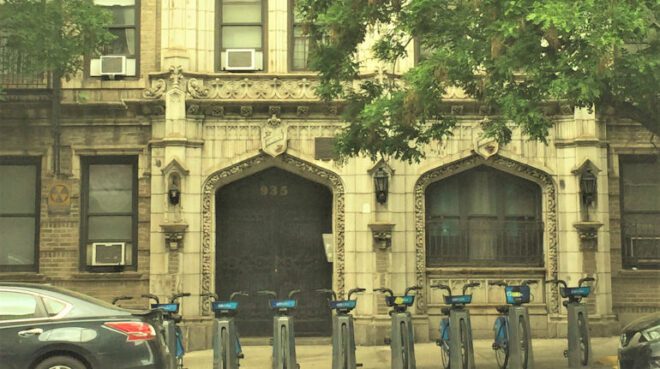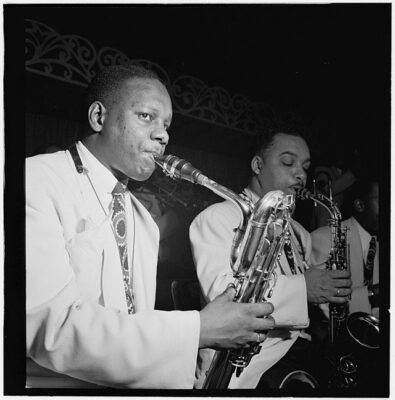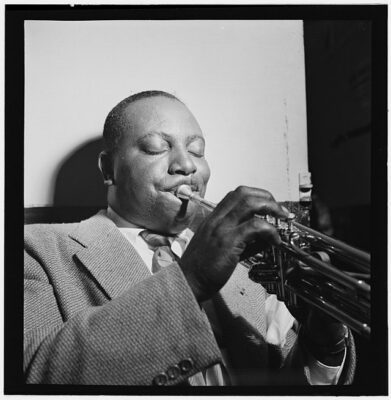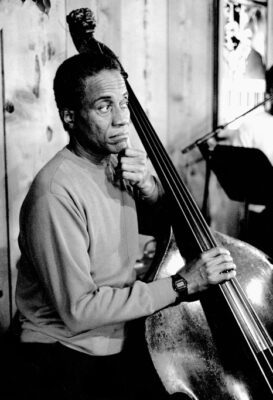Reveries of an Enchanted Evening with Maestro Duke Ellington
April 29th will mark the 123rd anniversary of the birth of Edward Kennedy Duke Ellington. Standing outside the elegant brick and stone building on St. Nicholas Avenue, in the Sugar Hill section of Harlem — which is referred to in the lyrics to “Take the A Train” — I listened to sonic gems from the late jazz master’s copious musical oeuvre through my earphones, sonic samples from a repertoire that includes over 2000 compositions. Now a national historical landmark, the unassuming and well-kept little building was the site of many of the Duke’s numerous compositions about his beloved Harlem.
Chillin’ in front of Duke’s crib, listening to “Take the A Train”, “Harlem Airshaft”, “Black, Brown and Beige Suite” and “Satin Doll”, I could feel his presence. And it resurrected memories of an enchanted evening I once spent with him in his downtown digs back in the early seventies, when the master was in the twilight of his wonderful life.

It was a soft, sparkling, lovely summer afternoon, and I couldn’t suppress the thought that I was about to experience a rare opportunity to witness history in the making. For just a few blocks from my crib on the upper west side, the best of the Afro-American and European orchestral traditions was being fused into a marvelous musical tapestry. The great Ellington Orchestra was participating in a collaboration with the “Symphony of the New World,” conducted by the renowned African-American cellist Kermit Moore — a founding member — for the express purpose of exploring the incandescent musical imagination of the peerless Edward Kennedy Ellington.
It was altogether fitting that the concert was held at Lincoln Center, the premiere venue of the Performing Arts, which was then the most conspicuous symbol of American cultural schizophrenia. The Jazz department, which was added a few years ago, is a prominent sign of recovery toward cultural wellness. To my mind at the time, this concert was the musical event of the season. I was convinced of this in spite of the rather astonishing fact that New York City was host to over fifty thousand musical performances that year! For this was a musical offering beyond category. The most consistently inventive musical craftsman in America, would preside over a posse of virtuoso instrumental pioneers, and their vast musical wisdom would be shared with some of the rising stars of the younger generation through the joyful experience of making music.

Seated side by side on the bandstand were vintage staples of the Ellington orchestra like Baritone saxophonist Harry Carney, Clarinetist/alto saxophonist Russell Procope, and trumpeter Cootie Williams, joined by brilliant young masters like bassist Richard Davis, cellist Kermit Moore, flautist Hubert Laws and violinist John Blair. And the Jazz master’s cookin’ solos were fired up by the lush sounds of the Symphony of the New World. Although these two musical aggregations were born of very different aesthetic impulses, they came together in perfect harmony on this divine day.

The Ellington Orchestra was organized to give expression to the Duke’s unique musical vision and prolific compositional gifts, which produced a fifty year flow of musical portraits and tone poems that captured the beauty and complexities of the cultural ambiance and lifestyles of black Americans, a virtual sonic kaleidoscope of Afro-Americana that captured the ethos of American civilization. And, I might add, contributed mightily to the creation of Jazz, a neo-African art form which provides a truer portrait of America than any of the paintings by the equally American school of “Abstract Expressionist” painters.

http://www.brianmcmillenphotography.com
Symphony of the New World
On the other hand, the now defunct Symphony of the New World — which was named after the famous composition by distinguished Bohemian composer Antonin Dvorak, which utilized Afro-American melodies as it’s central theme — was the Afro-American musician’s response to the racism and cultural chauvinism that continues to besmirch the reputations of the nation’s leading symphony orchestras. Hence that orchestra served primarily as a vehicle for those Afro-American composers, conductors and instrumentalists who chose to express themselves in the genre of wholly composed music. When these two orchestras merged in concert, it was clearly an artistic event of the first order.
The chain of events which led to my receiving a highly coveted invitation to the after party at Duke’s place began when the Maestro was greeting friends, fans and well-wishers backstage after the gig. As Duke graciously chatted with guests, Master John Blair — a colorful bald head character who looks like a bronze Mr. Clean but is a master of the martial arts and the violin — eased up behind Duke and started playing a medley of his tunes. Pleasantly surprised, Duke turned around broadly smiling and said: “So you’re a jazz violinist too huh?” Then he invited John to come party at his place. For my part, it was a case of being in the right place at the right time. Since Master John Blair was my main man, he invited me to tag along.
It was a short trip to Fifty Ninth Street and Columbus Circle, where Duke kept and apartment overlooking the southern most entrance to Central Park. Approaching the lobby to the building I reflected on the fact that at the turn of the century, a community known as “Black Bohemia” was located just a few blocks away. It was the home of such gifted Afro-American artists as Ubie Blake, Nobel Sissel, Will Marion Cooke, James Reece Europe, J. Rosamond Johnson, James Weldon Johnson, Bert Williams and George Walker.
These men played a vital role in both the creation of the American popular song — James Weldon Johnson was a founder of ASCAP — and the development of the American musical theater. Several of them influenced the musical development of Duke Ellington, especially conservatory trained composer and virtuoso violinist who was tutored by European masters Will Marion Cooke, with whom Duke studied music theory and called “Pops.”
As we entered Dukes apartment, we were greeted at the door by his sister Ruth, who proved to be a gracious and charming host throughout the evening. The first thing to seize my attention was a large white grand piano in the middle of the living room floor. Surrounded by a sea of white walls, drapes and carpet, the piano seemed to stand out as the central fact of this living space. The overall aesthetic effect was one of purity and singularity of purpose. It was sort of like entering a temple devoted to the making of music.
The scene was like a waiting group of religious devotees
I scanned the room, observing the anxious nervous energy displayed by various members of the group, as they anticipated the Duke’s presence. The scene had much in common with a group of religious devotees awaiting the presence of their guru. As we were introduced around, it became immediately clear that this assemblage comprised a unique collection of personalities. There were several aging members of the European nobility, sporting titles that suggested the grandeur of a now-forgotten world. There was a black expatriate symphonic conductor, forced to live in Sweden in order to practice his art. And a young black man exotically attired in a flowing black monk’s robe and a large straw hat, engaged in lively conversation with some erudite members of the Duke Ellington Society.
The gathering also included a smattering of the obligatory record executive types and a few solidly middle-class professionals. As I perused about the room, cocktail in hand savoring the excellent cuisine and listening to bits and pieces of conversations, I became aware of a sudden and dramatic change in the ambiance of the room. I looked around….and there he was, the musical genius who had left an indelible imprint on the music of America and greatly influenced the orchestral music of the world. Yes! There he was, Duke Ellington in the flesh, standing in his own living room. It was almost too much!
The Duke walked straight to the piano and sat down
After greeting us with his infectious charm and fabled smile, he walked straight to the piano and sat down. Strikingly and colorfully attired in a flowing red silk robe, complemented by a floor length white silk scarf, he seemed almost a different species of animal from the rest of us. It was easy to see how he got the name “Duke”, a name that suggests nobility. For he possessed the attributes that we have been conditioned to associate with a hereditary nobility. But Duke was a natural aristocrat, belonging to the aristocracy of talent and genius, which after all is the only one that really matters. And it soon became obvious that this critical distinction was also recognized by those ascribed aristocrats, who were born to the purple, yet sat around the room frozen in awe like relics from a European wax museum.
Everyone watched in amazement as the Duke secured his cigarette in an elegant holder fashioned from gold and ivory, then he began to lightly play through some of his tunes. As the evening progressed, I could clearly delineate various aspects of his character in the events that transpired. From the outset his total devotion to music was self-evident. And the requests arising from the guests testified to the universal appeal of his art. Some of these people had crossed an ocean to attend the concert earlier of the day. After a while, it was clear that several of the guests had seriously followed Duke’s work for thirty to forty years.
One could hear girlish laughter arising from the group as an elderly Countessa recalled first hearing a particular tune in Paris during the thirties, or was it Stockholm in the forties? In a business as fickle as music, it is difficult for an artist to retain a national audience for five or ten years. Yet here was a man who had retained an enthusiastic worldwide audience for fifty years! As Duke responded to requests and moved from one tune to another, I was impressed by the fact that most of these songs were now part of the standard repertoire of American music and admired worldwide.
Though we had all heard some of these compositions many times before, like all true classics, they retained a certain freshness and vitality. Sitting there watching the master at work in the intimacy of his living room, I desperately wanted to explore this fascinating creative personality. I silently longed for an opportunity to talk to him. I wondered at the artistic sensibility that could conceive these elegant tone poems, based in sophisticated urban blues and surrounded by consistently inventive orchestrations. And as the evening progressed, I managed to steal a couple of moments alone with him, which was something of a miracle as everyone was vying for his attention.
My brief conversation with the Duke
Although brief, the conversation was revelatory, as it provided an intriguing peek into Duke’s personality and his artistic method. And it is not always the quantity of the information but the quality that is most important. This has been demonstrated many times, Abraham Lincoln’s “Gettysburg Address” is a case in point. In a mere 13 lines Lincoln delivered one of the most significant speeches in U.S. history, and it is still being recited over a century and a half later. Such was the nature of my conversation with Maestro Ellington. “I am a Sophisticated Savage” he said with panache as we sat sipping cocktails in a corner of the living room.
Duke went on to tell me how he first came to New York as an art student at Pratt Institute, a distinguished college of art and design in Brooklyn, where he studied painting. He explained that when he later began composing music, he always had a visual image of his musical theme in mind. This explains why his music is often described in terms of colors: “Black, Brown and Beige Suite,” “Diminuendo in Blue,” “Black and Tan Fantasy,” “Mood Indigo,” et al. It also explains why he titles some of his compositions as “portraits.” I asked him about how he composed his suites to various parts of the world.
To my surprise, he said he never composed a note while he was actually in that country. “You see,” he explained, “I always wait until I am back home, because I want the music to be a creation of my imagination. And when I am in the country I may be too influenced by local musical traditions.” It is not often that one gets a chance to interrogate a creative genius about his method of making magic, hence the gravity of this rare moment was readily apparent, and I took note. Recollecting that enchanted evening, when in a serendipitous moment I found myself communing with a cultural Icon, alas, I have a profound regret. I didn’t review the concert because I just wanted to lay back and enjoy the music, and reviewing a performance is work. I felt no compulsion to review it because I was certain that a cultural event of this magnitude would be widely reviewed by major publications. But when I searched Google for them as I began to write this remembrance, I could not find a single one!
My one regret
I write about a broad range of issues in politics and culture. Politics as a duty, culture as a pleasure…albeit sometimes a guilty one. The first begs the question of how we shall make a living, the latter enriches our life. And often I chose to review works that I consider important but may escape the notice of corporate media critics, or I don’t trust them to do the subject justice. Hence I tend to write about the works of black Artists, from the U.S. and abroad, because I feel a thoughtful record should be made of their works that respects their intent for posterity. And thus my deep regret for not having reviewed this historic event.
Although Maestro Ellington was refused the Pulitzer Prize in 1964 for sustained excellence in orchestral music despite the fact that Duke had founded, conducted, and composed for one of the world’s most innovative and beloved orchestras for four decades — an act that the great cultural historian and critic Harold Cruse said was an insult to the entire Afro-American cultural tradition in his classic book, “The Crisis of the Negro Intellectual’ — Duke sold millions of records, won 14 Grammys, and was awarded an honorary Doctor of Music from Yale University three years later in 1967. Alas, the Pulitzer Prize Committee only recognized his contribution a quarter century after the Maestro had danced and joined the ancestors, awarding him a “Special Prize for Music” posthumously in 1999. Yet the racial and ethnic composition of his long-time admirers who came to gather on that enchanted evening in July, demonstrates that rest the world has long recognized the extraordinary creative contribution of the Duke. For as that 20th century Afro-American Renaissance Man, peerless Blues Philosopher and great writer, Albert Murray, opined, Maestro Ellington’s music is “a representative anecdote of U.S. civilization: America as she is swung!”
Watch the Ellington Orchestra perform “Take the A Train”
Keeping Ellington’s Legacy in Jazz at Lincoln Center:
Wynton Marsalis & The Young Stars of Jazz – “Take The ‘A’ Train“
